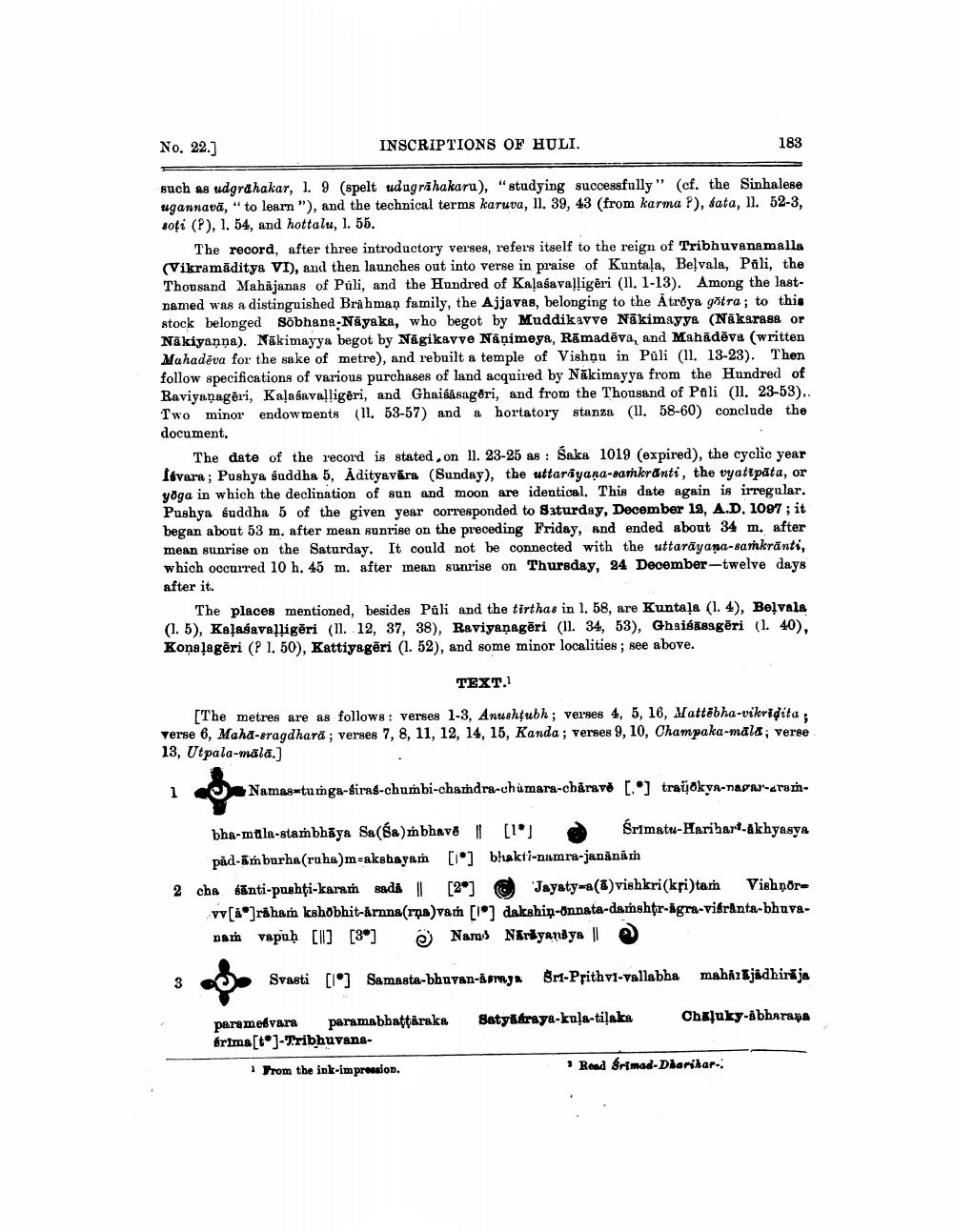________________
No. 22.]
such as udgrahakar, 1. 9 (spelt udugrahakaru), "studying successfully" (cf. the Sinhalese ugannavä, "to learn "), and the technical terms karuva, 11. 39, 43 (from karma ?), sata, 11. 52-3, soți (P), 1. 54, and hottalu, 1. 55.
INSCRIPTIONS OF HULI.
The record, after three introductory verses, refers itself to the reign of Tribhuvanamalla (Vikramaditya VI), and then launches out into verse in praise of Kuntala, Belvala, Pali, the Thousand Mahajanas of Puli, and the Hundred of Kalasavalligēri (11. 1-13). Among the lastnamed was a distinguished Brahman family, the Ajjavas, belonging to the Atroya götra; to this stock belonged Sobhana-Nayaka, who begot by Muddikavve Nakimayya (Nakarasa or Näkiyanna). Nakimayya begot by Nagikavve Nanimeya, Ramadeva, and Mahādēva (written Mahadeva for the sake of metre), and rebuilt a temple of Vishnu in Puli (11. 13-23). Then follow specifications of various purchases of land acquired by Nakimayya from the Hundred of Raviyanagēri, Kalasavalligēri, and Ghaisasageri, and from the Thousand of Puli (11. 23-53).. Two minor endowments (11. 53-57) and a hortatory stanza (11. 58-60) conclude the document.
The date of the record is stated, on 11. 23-25 as: Saka 1019 (expired), the cyclic year Isvara; Pushya suddha 5, Adityavara (Sunday), the uttarayana-samkranti, the vyatipata, or yoga in which the declination of sun and moon are identical. This date again is irregular. Pushya suddha 5 of the given year corresponded to Saturday, December 12, A.D. 1097; it began about 53 m. after mean sunrise on the preceding Friday, and ended about 34 m. after mean sunrise on the Saturday. It could not be connected with the uttarayana-samkranti, which occurred 10 h. 45 m. after mean sunrise on Thursday, 24 December-twelve days after it.
The places mentioned, besides Půli and the tirthas in 1. 58, are Kuntala (1. 4), Belvala (1.5), Kalasavalligēri (11. 12, 37, 38), Raviyanageri (11. 34, 53), Ghaisasageri (1. 40), Konalagēri (P 1, 50), Kattiyagēri (1. 52), and some minor localities; see above.
1
[The metres are as follows: verses 1-3, Anushṭubh; verses 4, 5, 16, Mattebha-vikridita verse 6, Maha-sragdhara; verses 7, 8, 11, 12, 14, 15, Kanda; verses 9, 10, Champaka-mala; verse 13, Utpala-mala.]
3
Namas-tumga-siras-chumbi-chandra-chumara-charave [*] traüokya-nagar-aram
bha-mala-stambhya Sa(Sa)mhbhars[1]
Srimatu-Harihar-akhyasya
pad-amburha (ruha)m-akshayam [*] bhakti-namra-janānāṁ
2 cha santi-pushți-karam sadā || [2*]
Jayaty-a(8)vishkri(kri)tam Vishnor
vv[a]raham kshöbhit-arnna(rna)vam [1] dakship-onnata-damshtr-agra-visranta-bhuvanam vapuḥ [] [3] Nam Narayanaya ||
Svasti [] Samasta-bhuvan-asraya Sri-Prithvi-vallabha mahārājādhirāja
Chaluky-abharapa
183
paramesvara frima [t]-Tribhuvana
paramabhaṭṭāraka
TEXT.1
1 From the ink-impression.
Satyaaraya-kula-tilaka
Read Srimad-Dharihar




